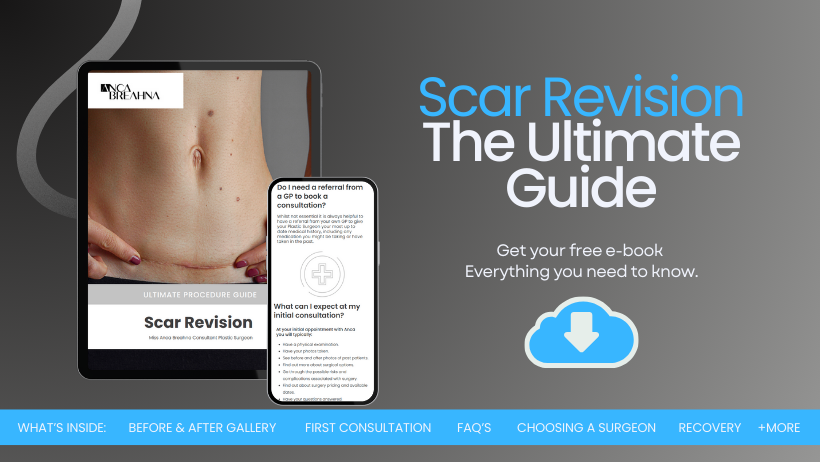
- Solutions to Reduce Breast Implant Surgery Scars
- Take our Plastic Surgery Quiz to find out if you'd be a good candidate for cosmetic surgery.
- Different Types of Breast Implant Incisions
- Download Miss Anca Breahna Breast Augmentation Guide
- What to Expect During Breast Implant Surgery
- How Scars Develop After Breast Implant Surgery
- Factors Affecting Scar Appearance after Breast Surgery
- How to Minimise Scars after Breast Surgery
- Treatment Options to Reduce Breast Implant Scars
- Breast Augmentation Before and After Photos
- Home Remedies to Minimise the Appearance of Breast Implant Scars
- Download Miss Anca Breahna’s Scar Revision Guide
- When to Consult Your Plastic Surgeon
- FAQs about Breast Implant Scars
- What are breast implant scars?
- Where are these scars typically located?
- How long does it take for the scars to fade?
- Are there ways to minimise the appearance of scars after surgery?
- How does massage help in scar reduction?
- Can laser treatments help in reducing scars?
- How can I prevent darkening of the scar due to sun exposure?
- Does the skill of the surgeon affect the appearance of scars?
- Are there any natural remedies to minimise scars?
- Will the scars ever disappear completely?
- Further Reading about Breast Surgery with Consultant Plastic Surgeon Anca Breahna
- Medical References about Breast Implant Scars
Solutions to Reduce Breast Implant Surgery Scars
Breast implant surgery is a common procedure, but what many people don’t realise is that it can leave visible scars. These breast implant scars often cause distress and self-consciousness, leading you to search for ways to diminish their appearance. It’s essential to understand that scars are a natural part of the healing process after any surgery, including breast implant surgery. They are the result of your body’s attempt to repair the skin and tissue damaged during the procedure. Before diving into the solutions to minimise breast implant scars, it’s crucial to know what you’re dealing with. Understanding the nature of these scars, what causes them, and how they develop, is the first step in your journey to tackle breast implant scars effectively.
Anca Breahna is a renowned plastic surgeon based in Chester, UK, specialising in breast surgery. She offers a range of breast surgery procedures including breast augmentation, breast reduction, and breast reconstruction, among others.
Take our Plastic Surgery Quiz to find out if you’d be a good candidate for cosmetic surgery.
Different Types of Breast Implant Incisions
The type of breast implant incisions your plastic surgeon makes during the procedure can influence the appearance and location of the scars. There are four main types of incisions: periareolar, inframammary, transaxillary, and transumbilical.
Periareolar incisions are made around the nipple. The resulting scars are usually well hidden, but there’s a higher risk of nipple sensation changes with this incision type. Inframammary incisions are made in the crease beneath the breast, resulting in scars that are hidden when you’re standing.
Transaxillary incisions are made in the armpit. This approach leaves no scars on the breast itself, but the scars can be visible when you lift your arms. Lastly, transumbilical incisions are made in the navel. This type of incision leaves no scars on the breasts, but it’s less commonly used due to the higher risk of complications.
Download Miss Anca Breahna Breast Augmentation Guide

What to Expect During Breast Implant Surgery
Breast implant surgery is a complex procedure that requires careful planning and preparation. During the operation, Anca will make incisions in one of the locations discussed earlier, create a pocket to place the implant, and then close the incisions.
While the surgery itself usually takes 1-2 hours, the recovery period can last several weeks. It’s during this time that the breast implant scars will start to form. Following your plastic surgeon’s post-operative instructions is crucial to minimise complications and promote proper healing.
Knowing what to expect during the surgery can help you feel more prepared and less anxious. It’s essential to ask your plastic surgeon any questions you have about the procedure, recovery, and potential scarring.
How Scars Develop After Breast Implant Surgery
After breast implant surgery, the healing process begins, and so does the formation of scars. Your body responds to the surgical incisions as wounds and starts repairing the damaged skin and tissue by producing new collagen fibres. This process results in the formation of a scar.
Initially, the scar may appear red and raised. Over time, it should gradually flatten and lighten in colour, blending more with the surrounding skin. This process can take up to a year or more.
The appearance of your scars can also be influenced by several factors, including your age, genetics, and overall health. Additionally, how you care for your wounds post-surgery can significantly affect how your scars develop.
Factors Affecting Scar Appearance after Breast Surgery
Several factors can affect the appearance of your scars after breast surgery. Individual characteristics, such as your age, skin type, and genetics, can influence how your body heals and how visible your scars become.
For example, younger skin tends to heal faster and produce less noticeable scars than older skin. Similarly, some people have a genetic predisposition to develop thicker, more noticeable scars. People with darker skin tones are more prone to developing hyperpigmented (darker) scars, while those with lighter skin may develop hypopigmented (lighter) scars.
How you care for your wounds after surgery also plays a significant role. Proper wound care can help prevent infection, reduce inflammation, and promote smoother, less noticeable healing.
How to Minimise Scars after Breast Surgery
There are several proactive measures you can take to minimise scars after breast surgery. These include following your plastic surgeon’s post-operative instructions, maintaining a healthy lifestyle, and using specific scar care products.
After your surgery, Anca will provide specific care instructions. These typically include keeping the area clean, avoiding strenuous activities, and wearing a support bra. Following these instructions can help prevent complications, reduce inflammation, and promote better healing, resulting in less noticeable scars.
Adopting a healthy lifestyle can also aid in your recovery. Proper nutrition provides your body with the necessary nutrients to repair damaged tissue, while regular exercise (once approved by your doctor) can improve circulation and speed up the healing process.
Scar care products, such as silicone sheets or gels, can also be beneficial. These products provide a protective barrier, maintain the skin’s moisture balance, and can help reduce the appearance of scars.
Treatment Options to Reduce Breast Implant Scars
If your scars are still noticeable after following the proactive measures, there are medical treatments available that can help reduce their appearance. These include laser therapy, microneedling, and scar revision surgery.
Laser therapy uses concentrated light to break down scar tissue and stimulate the production of new, healthy skin cells. Microneedling involves using tiny needles to create micro-injuries in the scar tissue, triggering the body’s healing response and promoting smoother, more even skin.
Scar revision surgery is a more invasive option and is usually considered when other treatments have been ineffective. This procedure involves removing the existing scar and repositioning the incision to make it less visible.
Breast Augmentation Before and After Photos
Home Remedies to Minimise the Appearance of Breast Implant Scars
In addition to medical treatments, there are home remedies you can try to diminish the appearance of breast implant scars. These include massaging the scar, using natural oils, and applying vitamin E.
Massaging the scar can help break down scar tissue and improve circulation to the area, promoting smoother, more even skin. Natural oils, such as coconut or rosehip oil, can moisturise the skin and promote healing.
Vitamin E is often recommended for scar care due to its antioxidant properties, which can protect and repair the skin. However, it’s essential to talk to your plastic surgeon before starting any new treatment, as some remedies may not be suitable for everyone.
Download Miss Anca Breahna’s Scar Revision Guide

When to Consult Your Plastic Surgeon
If your breast implant scars are causing you distress, or if they’re not improving despite your efforts, it’s time to consult your plastic surgeon. Anca can assess your scars and recommend the most effective treatment options for you.
Remember, it’s normal for scars to take time to heal, and the process can be slow. However, with patience and the right treatment, you can significantly minimise the appearance of your breast implant scars.
FAQs about Breast Implant Scars
What are breast implant scars?
- Breast implant scars are the fibrous tissue formations that develop at the site of surgical incisions made during a breast augmentation procedure. These scars are a natural part of the body’s healing process. The appearance, texture, and size of the scars can vary based on several factors, including the individual’s skin type, genetics, and the surgical technique used.
Where are these scars typically located?
The scars’ location depends on the surgical approach:
- Periareolar: Incision is made around the areola’s edge. This method often results in well-concealed scars as they blend with the areola’s natural border
- Inframammary: Incision is made in the crease under the breast, hiding the scar in the natural fold
- Transaxillary: Incision is made in the armpit. While this avoids scars on the breast itself, there can be a visible scar in the armpit area
- Transumbilical: Incision is made near the belly button. This approach leaves no scars on the breasts, but the scar near the navel might be noticeable
How long does it take for the scars to fade?
- Initial wound healing typically takes a few weeks. However, scars mature and fade over a more extended period, often up to 12-18 months. Factors like age, genetics, and skin pigmentation can influence the scar’s final appearance.
Are there ways to minimise the appearance of scars after surgery?
Several methods can help:
- Silicone Gel Sheets: These sheets hydrate the scar tissue, reducing its size and improving its colour
- Scar Creams: Products containing ingredients like silicone or onion extract can help in scar healing
- Massage: Regularly massaging the scar can soften the tissue and reduce its prominence
- Pressure Garments: Wearing these can flatten and soften scars
How does massage help in scar reduction?
- Massaging promotes blood flow, which can help in collagen distribution. It also helps in breaking down the dense bands of collagen that can make scars raised and noticeable.
Can laser treatments help in reducing scars?
- Laser treatments target the blood vessels in the scar tissue, reducing redness and improving texture. They can also stimulate collagen production, making the scar less raised and more similar to the surrounding skin.
How can I prevent darkening of the scar due to sun exposure?
- Sun exposure can cause hyperpigmentation in scars. It’s essential to cover the scar with clothing or use a high SPF sunscreen. Reapplying sunscreen every 2 hours when outdoors is crucial.
Does the skill of the surgeon affect the appearance of scars?
- A skilled plastic surgeon will use meticulous techniques to ensure minimal tissue trauma, leading to finer scars. They’ll also place incisions in areas that are naturally concealed or follow the body’s contours. However, it’s crucial to care for the wounds to ensure minimal scarring after breast implants surgery.
Are there any natural remedies to minimise scars?
While some natural remedies are believed to help, their efficacy isn’t always scientifically proven. For instance:
- Vitamin E Oil: Thought to improve skin elasticity and hydration
- Aloe Vera: Known for its soothing and anti-inflammatory properties
- Onion Extract: Found in some over-the-counter scar gels, believed to have anti-inflammatory effects
Will the scars ever disappear completely?
- Most scars fade significantly but don’t vanish entirely. The body’s healing process is designed to leave a mark as a reminder of past trauma. However, with proper care and interventions, they can become barely noticeable.
Further Reading about Breast Surgery with Consultant Plastic Surgeon Anca Breahna
- Read more about Mastopexy Augmentation (Uplift With Implants)
- Read more about Breast Implant Removal And Uplift
- Read more about How to Choose the Best Breast Implant Size
- Read more about Do I Need a Post Op Bra after Breast Surgery?
- Read more about Glamorous Breasts with Large Breast Implants
- Read more about When is a Good Time to Get Breast Implants?
Medical References about Breast Implant Scars
- Breast augmentation – Mayo Clinic
- Options in Cosmetic Surgery for Breasts (Mammoplasty)
- What sort of scarring could you see from breast augmentation?




 Ms Anca Breahna, PhD, MSc, FEBOPRAS, FRCS (Plast) is a highly regarded Consultant Plastic Surgeon specialising in the field of Aesthetic and Reconstructive Plastic Surgery. Anca performs a range of
Ms Anca Breahna, PhD, MSc, FEBOPRAS, FRCS (Plast) is a highly regarded Consultant Plastic Surgeon specialising in the field of Aesthetic and Reconstructive Plastic Surgery. Anca performs a range of 